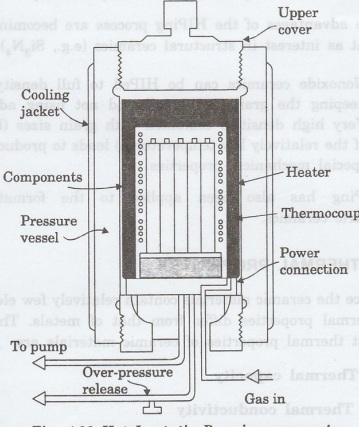Physics For Civil Engineering: Unit IV: New Engineering Materials
Gas Pressure Bonding
Hot isostatic pressure
The Hot Isostatic Press (HIP) uses the simultaneous application of heat and pressure. We refer to this process as HIPing and the product as being HIPed.
GAS PRESSURE BONDING
Hot
isostatic pressure
The
Hot Isostatic Press (HIP) uses the simultaneous application of heat and
pressure. We refer to this process as HIPing and the product as being HIPed. A
furnace is constructed within a high-pressure vessel and the objects to be
pressed are placed inside. Figure 4.23 shows a typical HIP arrangement.

Temperatures
can be upto 2000°C, and pressures are typically in the range of 30 - 100 MPa. A
gas is used as the pressure medium unlike in the CIP where a liquid is often
used.
Argon
is the most common gas used for HIPing, but oxidizing and reactive gases can be
used. Note that the high-pressure vessel is not inside the furnace.
There are two variants of HIPing.
• Encapsulated: using a deformable container
• Not encapsulated: shape and sinter
first, then HIPed
• Now HIPing is used for a wide variety
of ceramic (and metallic) components, such as alumina-based tool bits Sis bez
and the silicon nitride nozzles used in flue-gas desulfurization plants by the
utility industry.
The advantages of the HIPing process are
becoming more important as interest in structural ceramics (e.g., Si,N) grows.
• Nonoxide ceramics can be HIPed to full
density while keeping the grain size small and not using additives. Very high
densities combined with grain sizes (because of the relatively low temperatures)
leads to products with special mechanical properties.
Physics For Civil Engineering: Unit IV: New Engineering Materials : Tag: : Hot isostatic pressure - Gas Pressure Bonding
Related Topics
Related Subjects
Physics for Civil Engineering
PH3201 2021 Regulation | 2nd Semester Civil Dept 2021 Regulation
